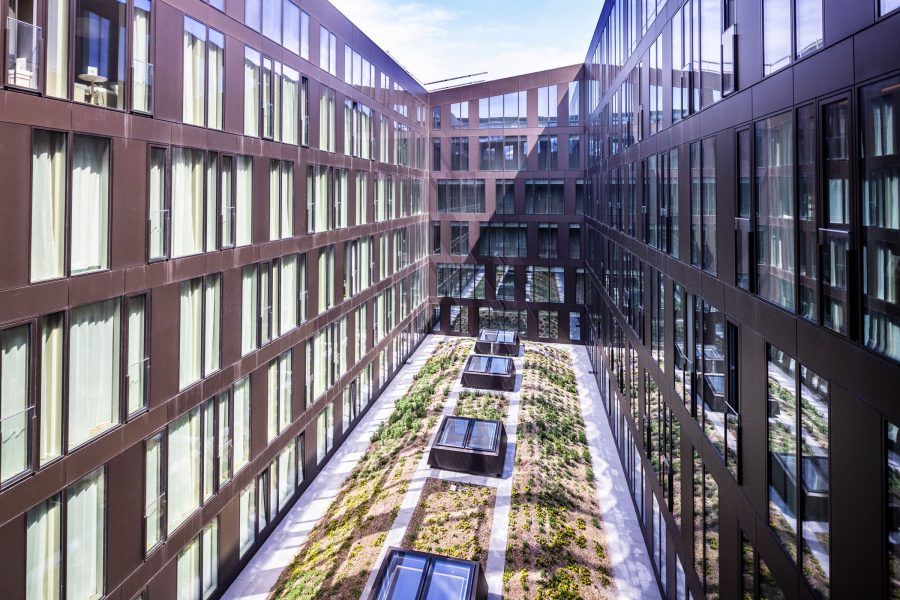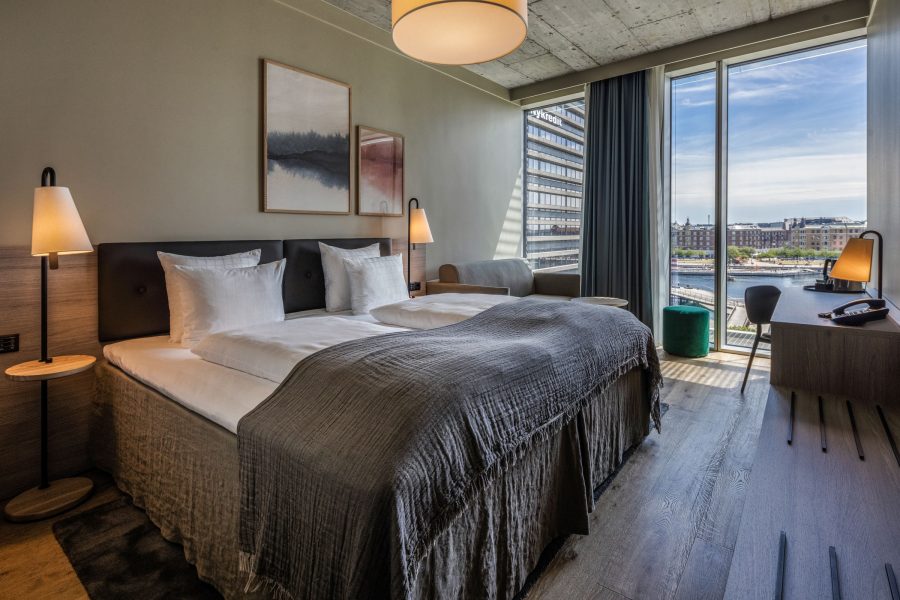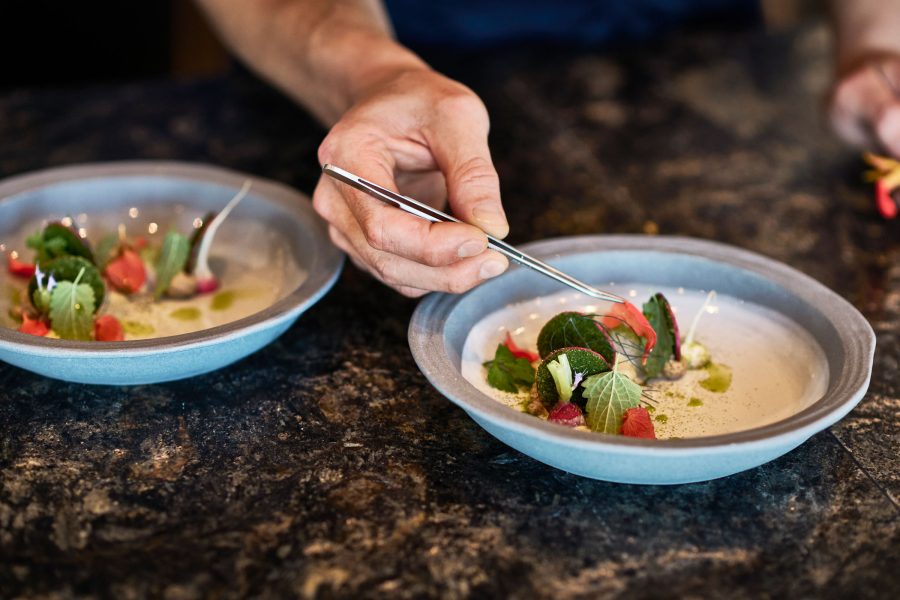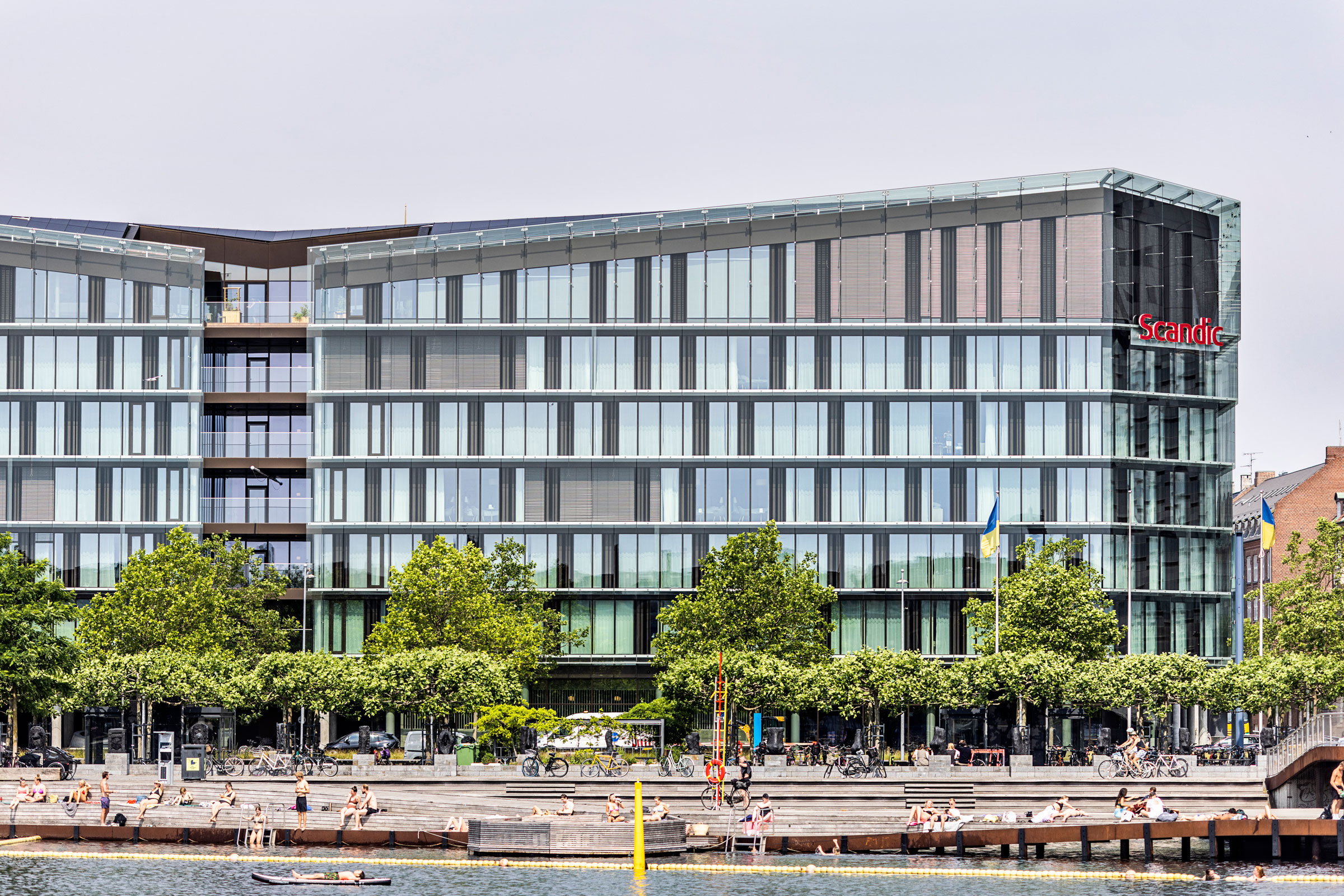Story at a glance:
- Scandic Spectrum opened in 2022 just one block from the water on Kalvebod Brygge, walkable to Copenhagen city center.
- Dissing+Weitling designed the seven-story hotel with a glass facade for a healthy indoor climate, optimal soundproofing, and natural light.
- The property is also known for its spa environment with heated pool, Finnish sauna, steam bath, spa treatments using natural products, and more.
Steps from the Copenhagen harbor, Scandic Spectrum is a new green hotel that celebrates nature while offering guests modern comforts centered on sustainability. From some rooms, guests look out over the waterfront as people take bold plunges regardless of the weather, then warm up in waterfront saunas. Hundreds of bicycles pass by on their way to the city center. All around you, a buzzing environment beckons you to get in on the fun, whether it’s getting outside on a bike or a boat, enjoying the finest ingredients as part of an organic meal inside the hotel, or sitting back and celebrating the best of Danish hospitality and design. The hotel completes the new square, Under Krystallen at Kalvebod Brygge, according to architects Dissing+Weitling.
“The hotel is located right next to the waterfront, so it made sense to bring nature into the hotel,” says General Manager Kirsten Glente Grindsted. “On the ground floor, our two large atrium courtyards with green plants bring nature right into the hotel, while on the sixth floor you have a view of the city and the water from the rooftop terrace at restaurant Ansvar. The wellness area is also inspired by Scandinavian forests, fjords, and mountains to create the sense of peace and quiet that you recognize from nature.”
The hotel has more than 600 rooms (including dozens of accessible rooms, plus large meeting spaces) and offers quite literally the full spectrum of experiences for guests, “from a coffee shop and family-friendly pizza at the ground floor to an extraordinary wellness experience hidden underneath the hotel and fine dining with a focus on sustainability,” Grindsted says. “We have something for everyone, and we are very proud to host such a broad spectrum of people and experiences within these walls.”
Certified Sustainable

A rooftop terrace invites hotel guests or diners at restaurant Ansvar to get outside. Photo courtesy of Scandic Spectrum

The seven-story Scandic Spectrum in Copenhagen was designed by Dissing+Weitling. Photo courtesy of Scandic Spectrum
All of the company’s Danish hotels, including Scandic Spectrum, are certified with the official Nordic environmental certification—the Nordic Swan Ecolabel. This certification comes with a long list of criteria, including reducing energy consumption and water consumption, reducing the share of unsorted waste, and choosing environmentally friendly furniture and products.
“Living up to the criteria is such a big part of our daily operation that a lot of our colleagues take part in the sustainability work every day,” Grindsted says. “The Nordic Swan Ecolabel also requires that we involve our staff and communicate clear goals internally, so that we are in this together. That is such a valuable part of the certification because it creates a huge internal pride.”
The Nordic Swan Ecolabel is the toughest environmental certification when it comes to hotels and, along with Scandic’s Code of Conduct, it sets the bar very high for any materials chosen in a project, according to Tage Holck, director of technical services in Scandic Denmark. “At Scandic we prioritize recycled and reusable materials and furniture as well as eco-labeled furniture and products like beds and TVs. This allows us to easily take furniture apart and recycle or reuse them.”
The property takes sustainability even further with the DGNB certification—a system based on life cycle assessment, holistic approach, and performance orientation. Holck says this considers the environment, people, and economic efficiency in the planning, construction, and the operation of the hotel. “The certification ensures that we live up to the current regulatory requirements and are very energy-efficient but also prepares the hotel for future environmental requirements,” he says.
“The work behind the DGNB certification improves the indoor environment, natural lighting, air quality, and acoustics, but it also contributes with significant financial benefits, including costs of operations and maintenance as well as high resale value of the building because of the sustainability certification,” Holck says.
Sustainable Details

A superior plus room at Scandic Spectrum overlooks the harbor in Copenhagen. Material choices in rooms reflect the hotel’s commitment to sustainability and biophilic design. Photo courtesy of Scandic Spectrum

Sun and greenery fill the atrium at Scandic Spectrum in Copenhagen. Photo courtesy of Scandic Spectrum
This mission is clear in the hotel’s details, from lighting to solar panels to the building’s facade. “We have put a lot of thought into making our lighting smart and efficient, while contributing to a great guest experience,” Holck says.
Guests can turn all lights off in their rooms by removing the key card or using the main switch. Sensors in all common areas track natural light to ensure artificial light is only used when absolutely needed.
“We have also tailored the lighting in all common areas in order to create the right atmosphere and level of brightness for that particular area. At the reception area the lighting is adapted to the different times of the day with brighter lighting during the day and a more dimmed lighting in the evening where we have less people at the front desk. In areas that are less crowded like hallways and staircases we have installed movement sensors to make sure we only light up these areas when it is necessary.
Using the lighting in a smart and efficient way while creating the right atmosphere for our hotel guests is definitely something that we are proud of,” Holck says.
Solar panels cover approximately 50% of the top of the hotel, producing 15% of the total amount of power that the hotel requires. The remaining power is supplied from renewable energy resources.
Scandic Spectrum also has double skin facades, meaning the facade system has two layers—an outer and an inner facade, separated by a cavity. “The gravity works as a thermal buffer that reduces the heat loss in the winter and reduces the heat in the summer,” Holck says. “The cavity can be vented in the top and bottom in order to cool or heat up the room—instead of always using a cooling or heating system within the building. The double skin facade is great and also reduces noise from Kalvebod Brygge and the busy hotel surroundings.”
Scandic Spectrum also uses district cooling to regulate the hotel’s temperature; the hotel can save energy by using the temperature of the nearby sea water—distributing chilled water to the building through a network of pipes, Holck says. “It also means we did not have to have a noisy local system for room temperature regulation at the hotel roof and had the opportunity to install solar cells instead.”
More than 30% of the food served in the hotel’s restaurant is organic, and employees actively work to reduce food waste. This includes a collaboration with a food waste app called Too Good To Go, where people can save leftovers from the breakfast buffet. Since 2017 the hotel has saved 150,000 meals through the app in Denmark alone.
Holck expects hotels like Scandic Spectrum and others to continue to raise the bar for sustainability well into the future. “The certifications are continuously improved with tougher criteria every time, which is a great foundation for development. A sustainable design within the hospitality industry is not just great for the planet but is also valuable to our customers and gives the building a higher value.”

At Ansvar Restaurant inside Scandic Spectrum in Copenhagen, you can buy sustainably caught fish or pork and lamb from local suppliers with a focus on animal welfare. Tableware and menus are made from recycled materials, and the hotel works to prevent food waste by using all parts of each ingredient and converting the excess parts into puree, stock, or dried herbal powder. Photo courtesy of Scandic Spectrum



